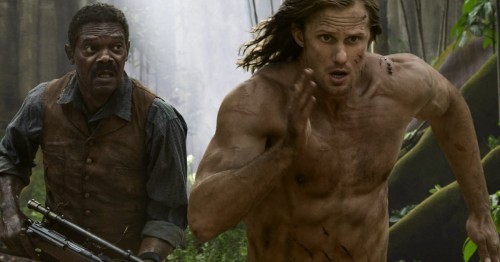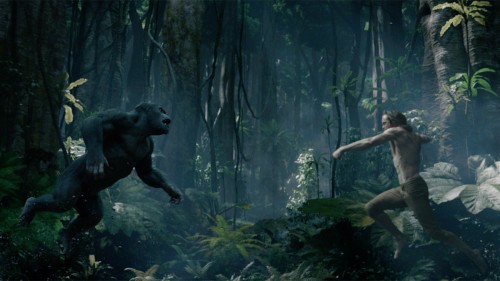Prime Focus and Technicolor join forces using FilmLight’s BLG workflow to ensure director can see completed grades throughout stereo conversion process
Director David Yates wanted a big, expansive feel for his fresh take on the Edgar Rice Burroughs classic, The Legend of Tarzan starring including Alexander Skarsgård, Samuel L. Jackson, Margot Robbie and Djimon Hounsou with Jim Broadbent and Christoph Waltz. The production decided early to employ stereo conversion for the 3D theatrical release of the film and having previously worked together on the stereo version of Harry Potter and the Deathly Hallows, Yates approached stereographer Richard Baker to supervise the stereo for The Legend of Tarzan, bringing Prime Focus World on board to deliver the 3D version of the movie.
Most of the effects work for this Warner Bros. Pictures/Village Roadshow Pictures epic action adventure, as well as the final finish, was completed in London.
“There were 1713 shots in the 110 minute movie, and more than 1200 of them were VFX shots,” recalled Baker. “We worked with numerous CG creative groups, including Framestore, MPC, Lola, Method, Rising Sun and One of Us.”
Due to its close working relationship with the VFX vendors, Prime Focus was able to harvest elements packages for many of the more complicated scenes, allowing for more detail and accuracy in the stereo conversion. “We work up scenes, and sequences, and reels until I’m happy that the depth is working to my satisfaction, supporting the narrative,” Baker said. “Then I will review with David and implement his notes. It’s a very collaborative process.”
That cooperation, however, led to an important challenge, which was partly due to the fact that the 2D and 3D versions were being finished at the same time. Yates was working on the grade with supervising visual colourist Peter Doyle at Technicolor, developing the final look of the movie. But when he went across town to review the stereo conform with Prime Focus, he would be seeing the film without Doyle’s grade.
“I got in touch with Technicolor and explained that David would like to see the stereo version of the film with Peter’s grade, even as it was developing,” said Baker. “They said ‘OK, we can provide you with BLGs.’ I was unfamiliar with the format, so I spoke to our internal pipeline team and confirmed that it was a Baselight node that we could run in the NUKE compositing application.”
What Baker discovered was the seamless, render-free workflow based on FilmLight’s Baselight Linked Grade (BLG) metadata format. It means the colour decisions made by the colourist are neither baked into the content, nor are they restricted to the colour suite. Peter Doyle could publish grades as they were completed, and simply by transferring a compact, XML file containing the BLGs, the grading decisions could immediately be imported into Prime Focus’s stereo comps. Then, when Baker reviewed the 3D version of the movie with the director, it was a faithful representation of the grade that Doyle had set.
Better still, since FilmLight made it free to use Baselight Editions to read and render grades last November, it meant that the Prime Focus artists could simply load the grade into NUKE without needing to purchase a licence. Eliminating licence fees for using the system meant there was no cost limitation on the workflow: everything worked more effectively and efficiently on as many NUKE workstations as needed it.
“It was important that we were presenting David with our stereo work in the correct colour space. The alternative would have meant exporting finished grades, which would have been extremely laborious for Technicolor,” said Baker. “I really do not think there is any efficient alternative to FilmLight’s BLG workflow. We could have had a close grade through a 3D LUT, but it wouldn’t have had any of the power windows, vignettes or extras. The FilmLight free-to-read licence delivers all the layers that the colourist is using, so there is no approximation.”
“When we were at our peak on this film we were reviewing over 200 shots a day,” he continued. “And on a project of this importance I might see every shot 15 or 20 times as it goes through the stereo workflow. The fact that we were able to get BLG updates from Technicolor, and import the latest grades with minimal effort, was fantastic.”
With the primary finish completed in 2D, the second part of the process was to adjust the grade for the 3D version. “There were a few dark scenes in the movie which we slightly lifted in 3D to allow the audience to see the fall off in the depth,” Baker said.
“Equally, if you have a classic over-the-shoulder shot it can be a bit distracting in 3D. So often we grade the foreground down so your eyes naturally fall onto the focus of the shot. And, of course, 3D glasses mean you lose a little brightness, so the grade had to take this into account as well. In all, I spent about two weeks with David and Peter at Technicolor grading the 3D version of the film.”
From not realising it was even possible, Baker is now an enthusiastic adopter of the BLG-driven workflow. “Even if I wasn’t showing work to the director, being able to review and finesse content in the final colour space of the film is invaluable,” he said. “This is particularly important in stereo, as colour can have such an impact on how the 3D works. I would absolutely use this workflow again whenever possible.”





